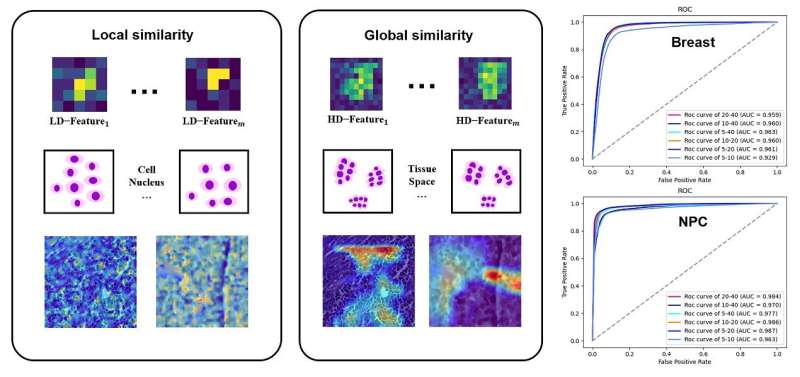This article has been reviewed according to Science X's editorial process and policies. Editors have highlighted the following attributes while ensuring the content's credibility:
fact-checked
trusted source
proofread
Deep multi-magnification similarity learning helps histopathological diagnosis

In clinical applications, pathologists usually combine information of histopathological images at different magnifications, that is, from subnuclear O (0.1 μ m) to cells [≈ O (10 μ m)] and intercellular [≈ O (100 μ m)], to other larger tissues [≈ O (1mm)] for diagnosis.
Magnification-based learning networks, which usually combine information at different magnifications, have attracted considerable attention for their ability to improve performance in histopathological classification.
Recently, a research team led by Dr. Qin Wenjian from the Shenzhen Institute of Advanced Technology (SIAT) of the Chinese Academy of Sciences, together with Prof. Luo Weiren's team from Shenzhen Third People's Hospital and Prof. Nazar Mustafa Zaki's team from United Arab Emirates University, proposed a novel deep multi-magnification similarity learning (DSML) approach to improve performance in histopathological classification.
The study was published in IEEE Journal of Biomedical and Health Informatics on Jan. 16.
The DSML focuses on tumor histopathological diagnosis by deep learning on digital pathology, which can be useful for the interpretation of multi-magnification learning frameworks and easy to visualize feature representation from low-dimension (e.g., cell-level) to high-dimension (e.g., tissue-level).
"It can overcome the difficulty of understanding cross-magnification information propagation," said Dr. Qin. "It uses a similarity cross-entropy loss function designation to learn the similarity of the information among cross-magnifications simultaneously."
The researchers designed different network backbones and magnification combinations to verify the effectiveness of DMSL on a clinical nasopharyngeal carcinoma and a public breast cancer BCSS2021 dataset.
They also investigated its ability to interpret. The results showed that it performed better in classification with a higher value of area under curve, accuracy and F-score than other comparable methods.
More information: Songhui Diao et al, Deep Multi-Magnification Similarity Learning for Histopathological Image Classification, IEEE Journal of Biomedical and Health Informatics (2023). DOI: 10.1109/JBHI.2023.3237137





















